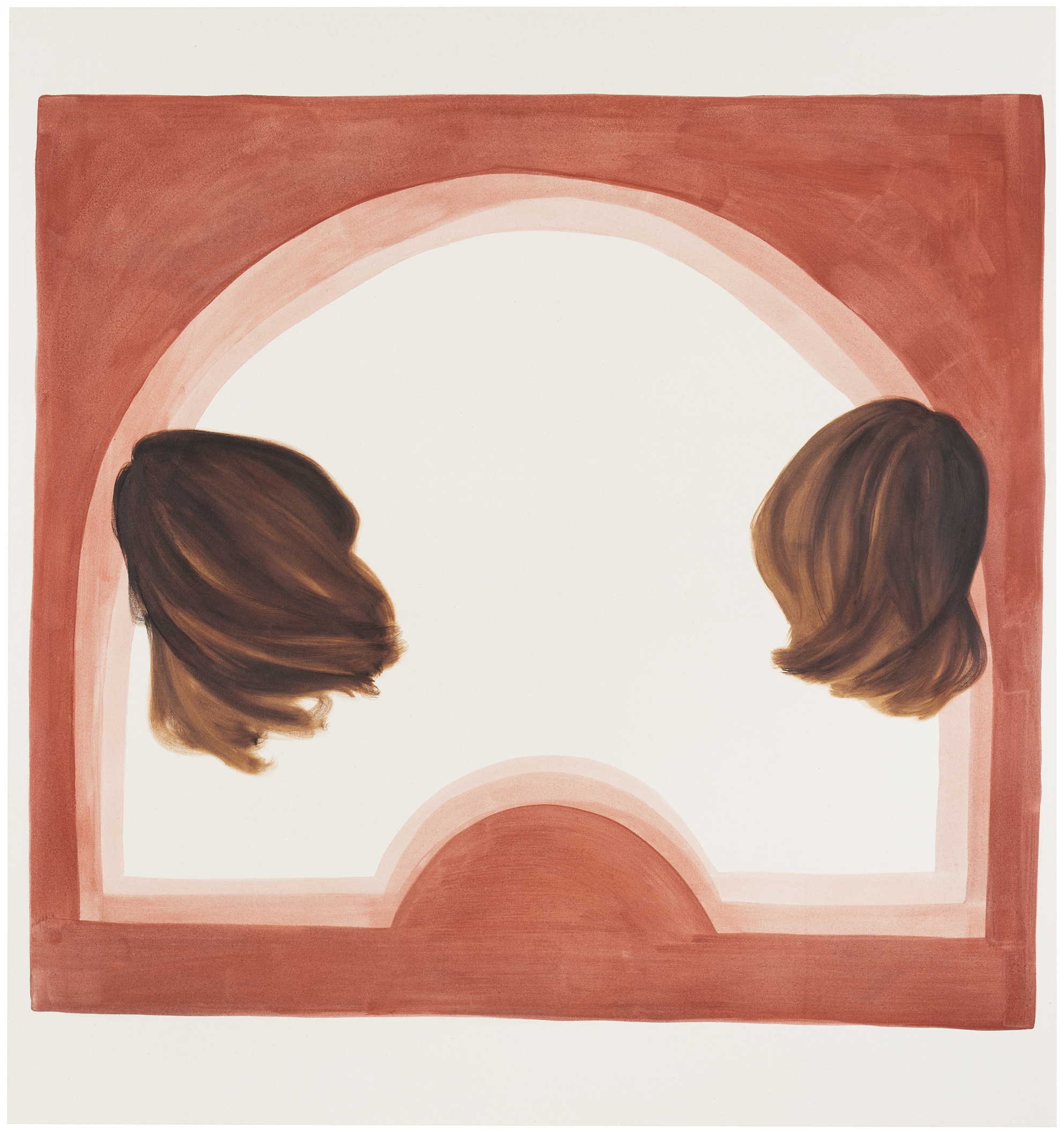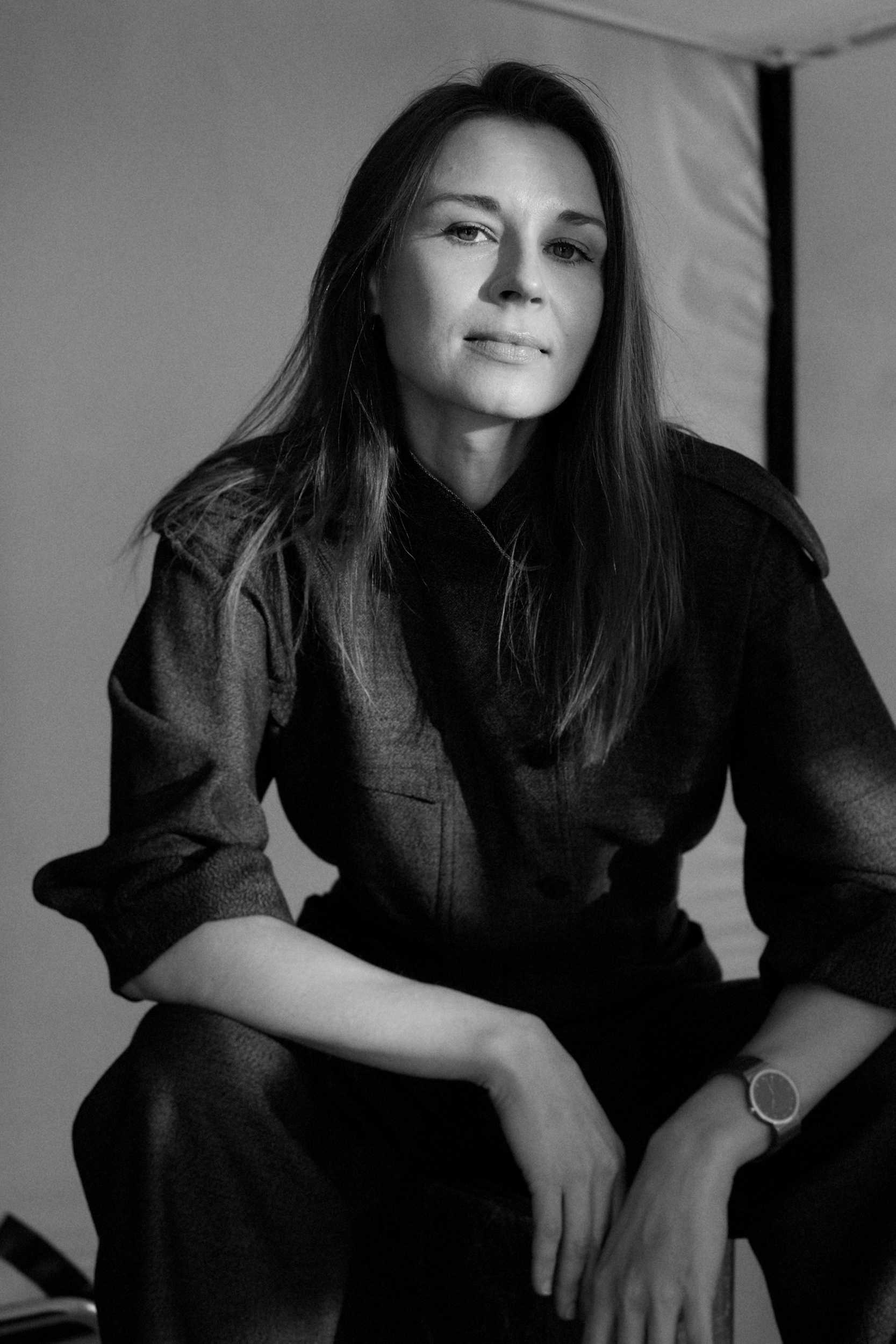
Helsinki Contemporary is delighted to be launching its spring season with Eeva-Riitta Eerola’s solo exhibition Locus. This suite of paintings has been built around themes of experientiality, the body and the sensory perception of space. These themes derive from the artist’s visit to the Museo Nazionale di San Marco, set in an old Dominican convent in Florence, and on her multisensory, analytical experience of Fra Angelico’s frescos. Continuing on from Eerola’s earlier production, the exhibition challenges those who experience it to look and to sense the works holistically – viewing them from the outside or merging to become part of them.
The title of the exhibition, Locus, refers to the experience of a space, to the place where something is happening or to where something is situated. It underscores the holistic nature of the sensory perception of space and the significances of the mutual relationship between human being and space. The physical experience of Fra Angelico’s convent frescos encapsulates something fundamental about painting and the experiencing of space, both on an emotional level and via conscious perception. “My own viewing experience when faced with Fra Angelico’s frescos is one example of the ability of painting to be simultaneously fixed in time and place and totally outside of them. The frescos were painted almost 600 years ago, and yet, as I looked at them, in a way, the time separating them from me vanished. The works are, of course, rooted in their context and their time, but also in Fra Angelico and his assistants’ concrete labours, in their presence in the space, in the choices they made, and in the touch of their hands. When I was looking at the paintings, all of those levels were present for me in my own time as both a cognitive and a sensory experience,” Eerola says.
Eerola deals with delicate shifts between image and place in three series of works, Act, Observer and Passage. The symbols that appear in the paintings give rise to multiple layers in this suite of paintings. The Actseries refers to authorship, action and perception. The hands in the paintings are simultaneously like the author’s or viewer’s hands at this moment, while also referring to details in Fra Angelico’s frescos. The Observer painting series is based on a powerful, multifarious symbol, an eye shape reminiscent of that of an almond or shell. In these reductive paintings it refers to the main mode of sensory perception – looking. In thePassage series the accent is on the relationship between human and space – the experience of place. The fragmentary figures in the new paintings exist more in relation to the space than in Eerola’s earlier works. When working on the paintings in the Locus exhibition, the artist has drawn on the concepts of stratification, transparency, repetition and disintegration.
The choices of material in the works are closely linked to their contents. The unprimed canvas speaks of making the process visible and thematically of a study of the fresco technique. On the bare canvas, as in the frescos, the paint, and with it the image, becomes in some special way a part of the space.
Eeva-Riitta Eerola (b. 1980, Siilinjärvi) graduated from the Finnish Academy of Fine Arts in 2010 and also studied at the École nationale supérieure des Beaux-arts de Paris. She has exhibited in several group and solo exhibitions in Finland and abroad, e.g. at Galleri Bo Bjerggaard, Copenhagen, in 2015 and Gallery Jaus, Los Angeles, in 2014. Eerola's latest solo show, The Shape of Thing to Come, was seen at Helsinki Contemporary in autumn 2019. Her work is represented in a number of Finnish public collections, including Museum of Contemporary Art Kiasma, Saastamoinen Foundation, Sara Hildén Art Museum, and the Wihuri Foundation. In 2016, Eerola worked on the internationally prestigious ISCP (International Studio & Curatorial Program) residence program in New York. Besides that, she has collaborated with the video artist Jenni Toikka, their latest joint project being a site-specific exhibition at Maison Louis Carré, France, in autumn 2019. In 2021, Eerola’s works were shown in Art Center Purnu’s PINTA (surface) summer exhibition and as part of the hanging in Artek Helsinki’s shop. Thanks go to Arts Promotion Centre Finland (Taike), the Finnish Institute in Rome, and Jenny and Antti Wihuri Foundation for supporting Eerola’s work.
Helsinki Contemporarylla on ilo käynnistää kevätkausi Eeva-Riitta Eerolan Locus-yksityisnäyttelyllä. Maalauskokonaisuus rakentuu kokemuksellisuuden, kehollisuuden ja tilan aistimisen teemojen ympärille. Nämä pohjautuvat taiteilijan vierailuun San Marcon luostarimuseossa Firenzessä ja Fra Angelicon freskojen moniaistiseen ja analyyttiseen kokemiseen. Jatkumona Eerolan aiemmalle tuotannolle näyttely haastaa kokijaa katsomiseen ja aistimaan teoksia kokonaisvaltaisesti - ulkopuolelta tarkkaillen tai osalliseksi sulautuen.
Näyttelyn nimi Locus viittaa tilan kokemukseen, paikkaan, jossa jotakin tapahtuu tai jokin sijaitsee. Nimi alleviivaa tilan aistimisen kokonaisvaltaisuutta ja ihmisen ja tilan keskinäisen suhteen merkityksiä. Fra Angelicon luostarifreskojen fyysiseen kokemukseen tiivistyy jotakin olennaista maalauksesta ja tilan kokemisesta, sekä tunnetasolla että tiedollisen havainnon kautta. ”Oma katsomiskokemukseni Fra Angelicon freskojen äärellä on yksi esimerkki maalauksen kyvystä olla samaan aikaan kiinni ajassa ja paikassa ja täysin irti niistä. Freskot on maalattu lähes 600 vuotta sitten, ja kuitenkin niitä katsoessani aika tavallaan katosi niiden ja minun väliltä. Teokset kiinnittyvät tietysti kontekstiinsa ja aikaansa, mutta myös Fra Angelicon ja hänen avustajiensa konkreettiseen työhön, heidän läsnäoloonsa tilassa, tekemiinsä valintoihin ja käsiensä kosketukseen. Katsoessani maalauksia nuo kaikki tasot olivat läsnä minulle omassa ajassani sekä tiedollisena että aistimuksellisena kokemuksena”, Eerola pohtii.
Eerola käsittelee teoksissaan herkkiä siirtymiä kuvan ja paikan välillä kolmen kokonaisuuden, Act-, Observer- ja Passage-sarjojen kautta. Maalauksissa esiintyvien symbolien keinoin teoskokonaisuuteen syntyy kerronnallisuutta. Act-sarja viittaa tekijyyteen, toimimiseen ja havaitsemiseen. Maalausten kädet ovat samanaikaisesti kuin tästä hetkestä tekijän tai katsojan käsiä ja toisaalta ne viittaavat Fra Angelicon freskojen yksityiskohtiin. Observer-maalaussarja pohjautuu vahvan ja moninaisen symbolin varaan, mantelin tai simpukan muotoa muistuttavaan silmän muotoon. Pelkistetyissä maalauksissa se viittaa aistimisen keskeiseen muotoon, katsomiseen. Passage-sarjassa korostuu ihmisen ja tilan suhde, paikan kokemus. Uusien maalausten fragmentaariset figuurit ovat enemmän suhteessa tilaan, kuin Eerolan aiemmissa teoksissa. Kerroksellisuuden, läpinäkyvyyden, toistumisen ja hajoamisen käsitteistä taiteilija on ammentanut työskennellessään Locus-näyttelyn maalausten parissa.
Teosten materiaalivalinnat kytkeytyvät tiiviisti sisältöihin. Pohjustamaton kangas viestii prosessin näkyväksi tekemisestä ja temaattisesti freskotekniikan tutkimisesta. Paljaalla kankaalla, kuten freskoissa, maali tulee kuvan kanssa erityisellä tavalla osaksi tilaa.
Eeva-Riitta Eerola (s. 1980) valmistui Kuvataideakatemiasta vuonna 2010, ja on opiskellut myös École nationale supérieure des Beaux-arts'issa Pariisissa. Eerolan teoksia on nähty yksityis- ja ryhmänäyttelyissä Suomessa ja kansainvälisesti, muun muassa Galleri Bo Bjerggaardissa Kööpenhaminassa vuonna 2015 ja Gallery Jausissa Los Angelesissa vuonna 2014. Edellinen yksityisnäyttely Helsinki Contemporaryssa, The Shape of Things to Come, oli syksyllä 2019. Eerolan teoksia sisältyy useisiin suomalaisiin julkisiin kokoelmiin, kuten Kiasman, Saastamoisen säätiön, Sara Hildénin taidemuseon ja Wihurin rahaston kokoelmiin. Eerola työskenteli kansainvälisesti arvostetun ISCP:n (International Studio & Curatorial Program) residenssissä New Yorkissa vuonna 2016. Eerola on lisäksi tehnyt yhteistyötä videotaiteilija Jenni Toikan kanssa, viimeisimpänä yhteisprojektina paikkasidonnainen näyttely Ranskassa Maison Louis Carréssa, syyskuussa 2019. Vuonna 2021 Eerolan töitä nähtiin osana Taidekeskus Purnun PINTA-kesänäyttelyä sekä Artek Helsinki -myymälän ripustuksessa. Kiitokset Taike, Suomen Rooman-instituutti sekä Jenny ja Antti Wihurin rahasto taiteilijan työn tukemisesta.
Helsinki Contemporary har glädjen att inleda vårsäsongen med Eeva-Riitta Eerolas separatutställning Locus.Utställningsverken bygger på teman kring det empiriskt upplevda, kroppslighet och rumslig varseblivning. De har inspirerats av Eerolas besök på klostermuseet San Marco i Florens där hon kunde tillägna sig och analytiskt studera Fra Angelicos fresker. Utställningen är en fortsättning på Eerolas tidigare produktion och utmanar oss att se och uppleva verken ur ett helhetsperspektiv – både som utomstående observatörer och som involverade aktörer.
Utställningens namn Locus refererar till rumsupplevelsen, platsen där någonting sker eller befinner sig.Namnet framhäver den helhetsmässiga upplevelsen och betydelsen av människans rumsrelation. Den fysiska upplevelsen av Fra Angelicos klosterfresker sammanfattar någonting väsentligt hos måleriet och rumsupplevelsen, såväl på känslonivå som via reflekterande varseblivning. ”Min egen upplevelse inför Fra Angelicos fresker är ett exempel på hur en målning samtidigt förmår vara bunden till och helt frikopplad från tid och plats. Freskerna är målade för närmare 600 år sedan, och likafullt liksom försvann denna tidsrymd mellan dem och mig. Verken är naturligtvis bundna till sin kontext och tid, men också till Fra Angelico och hans assistenters konkreta arbete, deras närvaro i rummet, de val de gjorde och deras händers beröring. Då jag tittade på målningarna fanns alla dessa nivåer närvarande i min egen tid, både på ett medvetet plan och som en sinnesupplevelse”, berättar Eerola.
Eerola behandlar små förskjutningar mellan bild och plats i tre verkserier: Act, Observer och Passage. De olika symbolerna tillför målningarna en narrativ dimension. Serien Act refererar till aktörskap, handling och observation. De avbildade händerna är å ena sidan lika närvarande som konstnärens eller betraktarens händer, å andra sidan refererar de till detaljer i Fra Angelicos fresker. Serien Observer är baserad på en stark och mångtydig symbol, ögonformen som liknar en mandel eller en snäcka. I de stramt hållna målningarna refererar den till ett viktigt sinne, seendet. I serien Passage accentueras relationen mellan människan och rummet, platsupplevelsen. De nya målningarnas fragmentariska figurer har en starkare relation till rummet än i Eerolas tidigare verk. I sitt arbete med utställningens målningar har hon hämtat influenser från skiktning, transparens, repetition och upplösning.
Valen av material är starkt kopplade till verkens innehåll. Den ogrundade duken antyder att konstnären vill synliggöra arbetsprocessen och utforska freskotekniken tematiskt. Liksom i fresker förvandlas färgen på ogrundad duk på ett speciellt sätt till en del av rummet.
Eeva-Riitta Eerola (f. 1980) utexaminerades från Bildkonstakademin 2010 och har också studerat på École nationale supérieure des Beaux-arts i Paris. Hennes verk har visats på separat- och grupputställningar både i Finland och internationellt. Hennes förra separatutställning The Shape of Things to Come på Helsinki Contemporary visades hösten 2019. Eerolas verk ingår också många inhemska samlingar, såsom Kiasmas, Saastamoinenstiftelsens, Sara Hildéns konstmuseums och Wihuris fonds samlingar. Eerola har också samarbetat med videokonstnären Jenni Toikka. Deras senaste gemensamma projekt var en platsspecifik utställning på Maison Louis Carré i Frankrike i september 2019. År 2021 visades Eerolas verk på konstcentret Purnus sommarutställning PINTA samt i affären Artek Helsinki. Vi tackar Centret för konstfrämjande TAIKE, Finlands Rominstitut samt Jenny och Antti Wihuris stiftelse för deras stöd till konstnären.

Share this exhibition